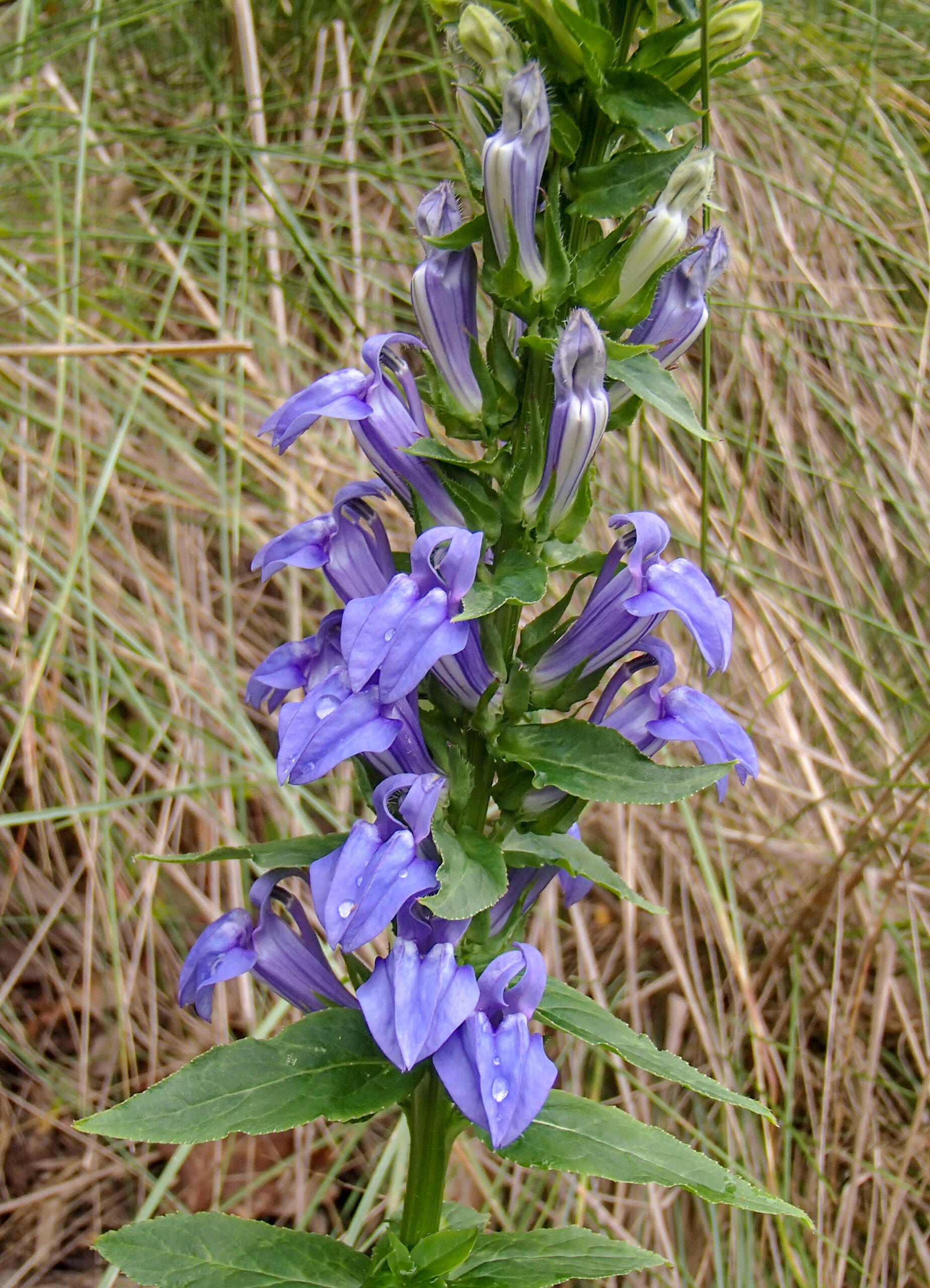The Great Blue Lobelia is a colony-forming, clumping perennial which is well known for its long-lasting, deep violet-blue floral spires from late summer to mid-autumn. The deep blue floral racemes play exceedingly well against the dominant yellows of other fall garden greats, and draw their own share of butterflies, bees and hummingbirds. In nature, Blue Lobelia is found in wet habitats throughout eastern U.S. It bears dense spikes of intensely blue, bilaterally symmetrical flowers on the tops of sturdy, two- to three-foot stems. The florets are tubular with a two-lobed upper lip and a more prominent three-lobed lower lip. In the garden, Blue Lobelia thrives in wet to moist soil and partial sun. Full sun is tolerated if the soil is consistently moist, and it will also grow in bright shade. The soil should be fertile and loamy, acid to circumneutral pH. After seeds are produced, the flowering stem and roots die, but new offsets are formed which generate their own roots. These small offsets should be protected for the following season.
NURSERY HOURS
Wednesday: 10-4 Thursday: 10-6 Friday-Saturday: 10-4 Sunday: 12-4
Lobelia siphilitica

Key Info
Scientific Name: Lobelia siphilitica L.
Common Names: Great Blue Lobelia, Blue Cardinalflower
Family Names: Campanulaceae (Bellflower Family)
Plant Type: Herbaceous perennial
Leaf Retention: Deciduous
Flower Color: Blue
Additional Info
Habit: In spring, mostly unbranched stems rise from a crown that occurs at ground level, forming spires of colorful florets in late summer/fall. Blue Lobelia is a tap-rooted, clumping perennial that forms robust winter rosettes and also new plants from rhizomes.
Height: 2' to 3'
Spread: 1' to 1½'
Soil Conditions: Wet to moist; pH acidic to neutral; humus-rich soil, medium loam, clay loam, sandy, sandy or gravelly loam, clay. Moisture is appreciated but this species is reported to be more drought tolerant than Lobelia cardinalis.
Leaves: The leaves are alternate, up to 5" long and 2" wide, larger at the bottom of the stalk and becoming smaller towards the top. They are lance-shaped to oval to elliptic, with serrated margins. The lower leaves clasp the central stem, while the upper leaves are sessile. They are dark green above, with short hairs, paler below. Larger than the leaves of Lobelia cardinalis.
Flowers (or reproductive structures: "The flowers are 1-1½" long, angled upward, and densely distributed along the raceme. Each flower has a blue-violet corolla (rarely white) that is narrowly bell-shaped (campanulate) and 2-lipped. The upper lip has 2 slender erect lobes that curve slightly inward or backward, while the lower lip has 3 descending lobes that are oblong-lanceolate. Near the throat of the flower at the base of the lower lobes, there is a pair of small white patches. The green calyx is deeply divided into 5 linear-lanceolate teeth; it is conspicuously hairy" (Illinois Wildflowers). The erect flowering spike, 1 to 2 feet tall, opens from the bottom up. The blooming period occurs from late summer to early fall, lasting about 6-8 weeks. There is no floral scent.
Fruit: The seeds come in two-celled, many-seeded capsules opening at the top. They are small, tan colored and ribbed and can be carried aloft by the wind in late summer/fall.
Natural Distribution: Great Blue Lobelia can be found in both disturbed areas and high quality habitats. Typically it grows in moist to wet locations such as open wet woods, meadows, swamps, stream banks, sloughs, springs.
USDA Hardiness Zone: 4 to 9
USDA Wetland Indicator Status in NC: FACW (OBL on coast)
Pollination: Primarily by bees.
Wildlife Connections: Attracts native bees, hummingbirds and butterflies. Deer and other mammalian herbivores generally avoid eating the plant because foliage contains toxic alkaloids. The ecological value of this species as well as of its cousin the Cardinalflower is considered limited by Illinoiswildflowers.info.
Propagation: By division of clumps in the spring or from stratified seed.
